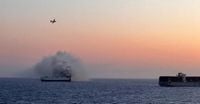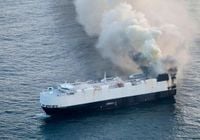On June 3, 2025, the cargo ship Morning Midas, carrying approximately 3,000 vehicles including 800 electric vehicles (EVs), caught fire about 300 miles south of Adak Island, Alaska, prompting a dramatic evacuation of its 22 crew members. The vessel, en route from Yantai, China, to Lázaro Cárdenas, Mexico, faced a blaze originating on a deck loaded with electric vehicles, raising concerns about the growing risks of transporting lithium-ion battery-powered cars by sea.
The Morning Midas, a 600-foot (183-meter) roll-on/roll-off ferry sailing under a Liberian flag, had departed Yantai on May 26, with stops at Shanghai and Nansha—major Chinese hubs for electric vehicle exports—before venturing across the Pacific. The ship was approximately 1,200 miles from Anchorage when smoke was first spotted emanating from the deck carrying the EVs, according to Zodiac Maritime, the London-based operator.
Despite the crew’s immediate response, activating the ship’s onboard fire suppression systems and initiating emergency firefighting protocols, the fire proved uncontrollable. Within 15 minutes of detecting the smoke, the crew issued a distress alert and abandoned ship, boarding lifeboats. They were swiftly rescued by the crew of a nearby merchant vessel, the Cosco Hellas, with coordination from the U.S. Coast Guard. All 22 crew members were reported safe with no injuries.
The U.S. Coast Guard dispatched aircrews to Adak and deployed a cutter ship to the scene, while three other vessels were already assisting. However, the fire on the Morning Midas continued to burn into the night of June 4, more than 24 hours after it began. Officials decided to monitor the blaze from a safe distance due to the volatile nature of lithium-ion battery fires, which can reignite and produce toxic gases, making firefighting efforts perilous.
"The relevant authorities have been notified, and we are working closely with emergency responders with a tug being deployed to support salvage and firefighting operations," Zodiac Maritime stated. "Our priorities are to ensure the continued safety of the crew and protect the marine environment." Rear Admiral Megan Dean, commander of the Coast Guard’s Seventeenth District, praised the rescue efforts, saying, "We are grateful for the selfless actions of the three nearby vessels who assisted in the response and the crew of motor vessel Cosco Hellas, who helped save 22 lives." She added that the Coast Guard was collaborating with Zodiac Maritime to determine the next steps for recovering the ship and handling the fire.
The incident highlights the unique challenges posed by electric vehicle fires at sea. Lithium-ion batteries, which power EVs, are highly flammable and can undergo thermal runaway—a rapid, uncontrollable overheating that can cause explosions and intense fires. Saltwater exposure can exacerbate this by short-circuiting battery cells, potentially triggering fires days after initial damage. These characteristics make such blazes difficult to extinguish, often burning hotter and faster than conventional fires and prone to reignition even after being doused.
Experts note that water, usually the first line of defense against fires, can be counterproductive when it comes to lithium-ion battery fires, especially at sea where saltwater is a better conductor of electricity. This paradox complicates firefighting efforts on vessels like the Morning Midas.
The risks of EV fires aboard ships are not new. In 2022, the Felicity Ace, a car carrier slightly larger than the Morning Midas, caught fire in the Atlantic Ocean. The blaze reportedly started when a lithium battery in a Porsche short-circuited, igniting a fire that burned for nearly two weeks. Despite efforts to tow the vessel to safety, it eventually sank off the Portuguese Azores archipelago, resulting in the loss of around 4,000 luxury vehicles, including Bentleys and Porsches.
Such incidents have intensified scrutiny on the safety protocols for transporting electric vehicles and other cargo containing lithium-ion batteries. Fires on container ships, car carriers, and roll-on/roll-off vessels have surged, hitting the highest levels in a decade by 2024, according to Allianz Commercial, an insurer. The company’s 2025 safety and shipping review report warned, "The reality is the risk remains significant due to the size of these ships and the complexities involved in firefighting and salvage." Insurance concerns are mounting as these large vessels, longer than three football fields in some cases, carry vast quantities of goods, including increasingly popular electric vehicles.
Electric vehicles themselves are a booming market worldwide. In Mexico, more than 60% of EVs sold in 2023 and 2024 were imported from China, underscoring the importance of safe maritime transport routes between the two countries. However, as these vehicles become more prevalent, the maritime industry faces mounting pressure to develop better emergency response strategies to handle the unique dangers posed by lithium-ion battery fires.
Meanwhile, efforts to manage the risks on land continue as well. Airlines in Asia and the U.S. have tightened restrictions on the transport and use of lithium-ion batteries onboard aircraft following incidents involving portable battery fires. These measures reflect a broader awareness of the hazards these batteries pose across transportation sectors.
The Morning Midas fire serves as a stark reminder of the evolving challenges in global trade logistics. With more than 80% of international trade by volume arriving via sea, the safety of shipping routes is critical. The incident also echoes calls from safety boards, such as the Dutch safety board’s recommendations after a deadly 2023 fire on a freighter carrying nearly 500 electric vehicles, to improve emergency responses on major shipping lanes.
As the Morning Midas continues to burn off Alaska’s coast, salvage teams prepare to tackle what promises to be a complex and hazardous operation. The priority remains clear: safeguarding human life and minimizing environmental damage while confronting the growing risks associated with transporting electric vehicles across the world’s oceans.



